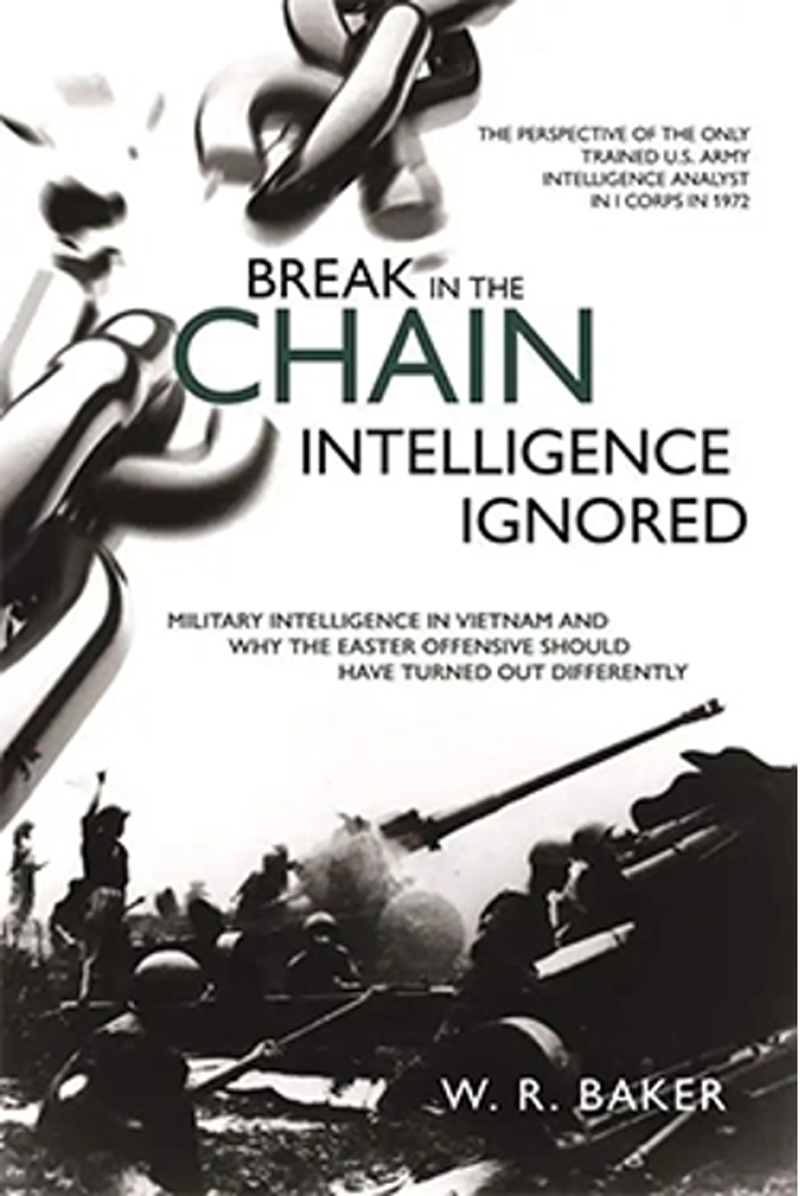Book Review
Break in the Chain — Intelligence Ignored Military Intelligence in Vietnam and Why the Easter Offensive Should Have Turned Out Differently
by W. R. “Bob” Baker
Casemate, Philadelphia (2021)
264 pages

Break-in-the-Chain-Book-Cover
By Greg Horton SGM (Ret)
The first thing I noticed is how the author began by describing his “Army Brat” upbringing and his family life providing a great personal touch. I enjoyed the highs and lows, trials, and tribulations of being the oldest of seven children as they moved to various bases and experienced the Army family lifestyle. He bounced around from Florida, to Alabama, to Germany and other places, learning many of life’s lessons. A very personal and enjoyable read, but then the letter from the Draft Board changed all that. Knowing that he would probably be drafted, Baker enlisted so he could pick his MOS.
I, like many of the readers, can identify with some of the stories that happened to him as he processed in. One of the funny moments (to me especially) was when the Marines entered the reception center and began picking people out. Then they yelled “Welcome to the United States Marine Corps!” I bet they were stupefied, because I had four of those “Draftees” in my USMC boot camp platoon and they were visibly shaken! And by the way, the Drill Instructors were really hard on them because all the rest of us volunteered!
Baker goes on to describe the rest of his training experiences and then entering the field of intelligence. He was in the first intelligence class to go to Ft. Huachuca, Arizona and describes the training that his class received. Upon completion of his training (graduating number one) and experiencing “The Barn” as his graduation exercise, he requested and was assigned to Vietnam. Now the “Meat and Potatoes” of the book begins.
When he arrived in Vietnam, Baker was initially placed with Headquarters (HQ), 525th Military Intelligence Group, located at the MACV Annex. He worked for the 1st Bn S-3 and goes on in the book to describe his day-to-day activities. Eventually he became a part of the 571st Military Intelligence Detachment and the book chronicles their activities. At this point the author begins to get in the nuts and bolts of the units in the area. One of the impressive things is the amount of research and footnotes provided to establish the various units, their locations, and their activities as the massive enemy offensive takes place during Easter 1972.
One of the recurring themes in this book is the failure of the commanders to heed intelligence provided by the personnel that worked at that for a living. One of his examples is the invasion of Laos in 1970.
“US Studies and Observations Group (SOG), however, repeatedly warned US Commanders not to go into Laos because they had been there and understood the depth of NVA strength in the area. Their warnings fell on deaf ears.” (Page 35)
When I read the author’s comments, I remembered that was something that I had heard before from a former SOG operator. I contacted “Ned” and he advised me that there were numerous times that they had “Actionable Intelligence” that was forwarded and never was acted on. There seems to be a number of these incidents that would back up the author’s claim. I recalled a conversation with a LRRP who elaborated on “Ned’s” assertions. “Don” told me that his team went out and gleaned constant intelligence, such as roads, POL points, vehicle storage and many other bits of intel. There were several times that this intelligence was not acted on. In fact, “Don” advised me that there were incidents where they were tasked to go back to a certain area and “verify” the intelligence they had provided, and felt that their intel people did not believe them. “Don” said that this was one of the most dangerous missions that they could go on, because the enemy knew that they had been there and were waiting for them to return.
Baker points out the numerous intelligence failures where the command neglected to act on information provided to them, especially by the 571st. If it was not so tragic, it would be comical. Baker relates how it was not until three days after the beginning of the Easter 1972 offensive that there was any concern in Saigon. This was in spite of the intelligence summaries they were receiving. Throughout the book, Baker uses countless examples of the chain of command ignoring or failing to pass on relevant and accurate intelligence that clearly indicated massing of troops and movement that would have enabled commanders to devise and execute plans to counter this massive offensive.
What is frustrating for me is the disregarding of intelligence, conflicting intelligence, viewing the intelligence with a jaundiced eye, or preconceived notions that Baker points out so well in this book. It would appear that our government has not learned a thing about intelligence, as we can see when asked about the chance of a Taliban takeover;
“No, it is not (possible). Because you have the Afghan troops have 300,000 well equipped, as well as any army in the world, and an Air Force against 75,000 Taliban. It is not inevitable.”
Baker Points out how this failure to use current and actionable intelligence took place and the pitfalls to avoid them in the future.
- Avoid the “Stove Piping” which is deferring to a command hierarchy, and relying on one form of intelligence.
- In the Easter Offensive of 1972, leaders were lulled into a kind of complacency by reports of the success of the Vietnamization effort.
- Be careful not to be telling the generals or command what they want to hear.
- Relying on one source of intelligence.
The bottom line is, if you want a well-sourced, intelligent book that is not afraid to broach serious subjects, then Break in the Chain — Intelligence Ignored is the one for you. Bob Baker lays out, in detail, the incredible intelligence failures in the war that are mind-boggling and, based on his vast experience, how to avoid them in the future.
About the Author:
Gregory Horton is current the President of Chapter 78. Read Greg’s Member Profile to learn more about him.

Leave A Comment